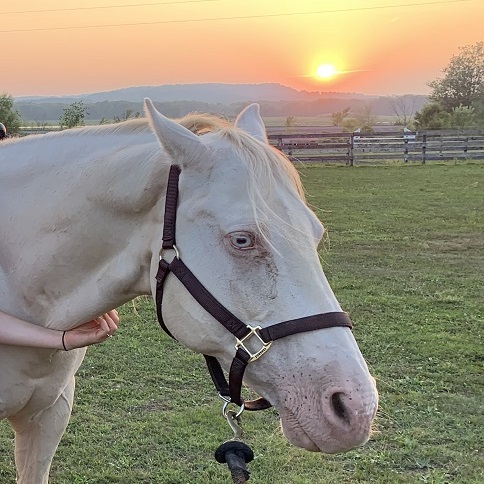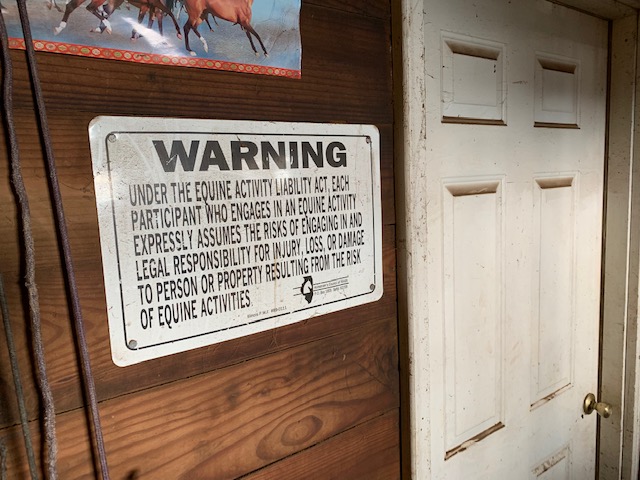
Equine Assisted Learning (EAL) for Adults and Teens
For adults and teens we offer oppoirtunity to interact with, learn from, and bond with our horses in a unique way.Pricing
Our 24,440 square foot equestrian center has a 60' x 160' indoor riding arena for rainy days.
Liability waiver required for all activities. ALL ADULTS MUST SIGN - whether riding or not! If you won't sign the waiver, please don't come onto the propterty.
To make a reservation
first schedule an event with Wrangler Roger and then go to Payment page and pay for the event.Therapeutic Horseback Riding (THR) and Equine Facilitated Learning (EFL) have been shown to be beneficial to humans.
Just being around horses can decrease anxiety, increase self-esteem, and provides "excitement without stress." The sciense is very interesting and compelling.
"Peacefully interacting with horses may move people to a heightened receptive state that enhances non-verbal communication."
"Equine Therapy and Animal Therapy are proven methods of managing trauma and lowering stress."
CBS News report - Ukranians use horses to process trauma of war.
Read more
Equine Assisted Learning (EAL) Exercises
These are some of the exercises we can set up for our guests and visitors to interact with our horses. Take a look at them and see which ones you think you might like to try out. We'll set up the exercise to help you and your family, friends, or co-workers learn together about communicating with horses and with each other.These exercises may be useful to:
Build interpersonal bonds,
Practice team problem solving,
Help express feelings,
Idefntify actions/choices,
Jump start parent-teen communications,
Improve communication between significant others,
Help moderate symptoms of PTSD, ODD, ADHD, Aspergers,
Teach respect for boundaries.
*******************************
String Relay
Set up:
Set up a start/finish line at one end of the arena.
A simple obstacle course in a line, such as weave 3 barrels, over a low cavaletti, over 3 ground poles, circle a barrel.
Set up a spot at the other end where someone stands - by a cone, in a hoola hoop, etc.
You can set up multiple courses if there are more people and room to do it safely.
Activity:
One team member stands at end end of the course.
The first member leads the horse with a string, such as a feed sack string, through the course.
They hand the horse off to the team member at the end who then leads the horse back through the course and across the finish line.
If the string breaks, they need to stop and retie the string to continue.
This can be done race-style if there are multiple courses, or with a timer if there is one course.
I think this could also be done with two people leading the horse, one on either side, each with a string.
Or perhaps it could be done with one person riding (200 lb wt limit), and the other leading with a string. There are many possible adaptations.
Discuss:
Teamwork and competition.
How you cooperated with the horse and team member.
Social/power dynamics within the group (or family members).
Pay It Out
Set up:
Set up a "tunnel" or "road" with ground poles or rope on either side, down the arena.
Inside the tunnel, set up barrels or cones all the way down.
You may add "temptations" or "difficulties."
Activity:
Each person leads their horse down the tunnel.
The person must stay outside the boundaries.
The horse must weave through the barrels/cones.
If the person/horse goes off course or crosses the boundaries, they must start over.
You could adapt this to have one person lead and one person ride (200 lb wt limit), etc.
Discuss:
Giving and receiving with the lead rope, and respect.
Communication process with the horse.
Horse's reactions to directions, temptations, challenges, and the leader's respect.
Difficulty with specific boundaries, temptations, challenges.
Trail of Support
Set up:
Set up an obstacle course around the arena with a start/finish, such as: go over 3 ground poles, over a cavaletti, weave the cones, over another cavaletti, over 3 ground poles, halt in the box.
Activity:
Participants attempt the course leading the horse several times, each time holding a different area of the lead rope: closer vs further away from the halter.
Can also be done in teams with one person on each side of the horse.
Discuss:
The horse's responses to directions and limits given.
Which tightness/looseness of the lead rope felt the most comfortable.
How tight does the lead rope (limits) on the horse, or others, or yourself need to be held to negotiate the course or life?
Where does the participant feel the most in control? If this reflected by the horse's behavior?
Flag Race
Set up:
At one end of the arena set up a start/finish line.
On one side of the arena set up a bucket with 3 Feelings Flags in it, the flags labeled "Happy", "Sad" and "Angry" (or customize these).
At the other end of the arena set up a cone or series of cones.
On the other side of the arena set up 6 Action Buckets, with the buckets labeled "Aggressive", "Anger Work", "Silly", "Play with Friends", "Tantrum" and "Express Feelings" (or customize these).
You may want to fill the buckets with sand so they don't tip over, and put them up on a barrel or pole so they are easily reached.
Activity:
The participant starts at the start/finish line
First they go to choose a Feeling Flag on their way to the end of the arena.
Second at the end of the arena they go around the cone/s.
Third, on their way back, they place the Feeling Flag in the Action Bucket of their choice, the action they think goes with that feeling.
Lastly they go back to the start/finish line.
Discuss:
Talk about the horse's feelings and actions in the activity.
Which Feeling Flag they picked and why.
How they picked that Action Bucket for that feeling.
How feelings are followed by actions in life. Can you use actions to affect feelings?
Charades
Set up:
A horse or two.
A place to act out the charade with the horse.
A a place for the observers.
Activity:
Play charades, role-playing with the horse a real life situation. You can let them choose what to portray, or give them a specific scenario or emotion.
Play either one person at a time with the rest observing, or with two person teams with the other teams observing.
After the time limit (you decide how long), the other observers/teams need to guess the situation or explain what they observed.
Discuss:
Observations about body language, eye contact, verbal communication.
Guess emotions and discuss degree of expression.
Responses from the horse (attention, body language, non-verbal communication, eye contact, etc.)
The above exercises were copied from "lessonsintr.com." We try to be creative and may use some of these ideas or create new challenges on the spot.
****************
 Just hang out with horses. Watch the sun set over the Mississippi river while you feel the heartbeat of your favorite horse.
Equine Assisted Learning has been shown to have all sorts of benefits for our health and happiness.
Just hang out with horses. Watch the sun set over the Mississippi river while you feel the heartbeat of your favorite horse.
Equine Assisted Learning has been shown to have all sorts of benefits for our health and happiness. Equine Facilitated Therapy (Without the Therapy)
We do not do Equine Facilitated Therapy because we do not have a therapy license. But we can walk you through some of the exercises with our horses. EAL is essentially EFT without a Therapist. A June 2023 study explored "The Therapeutic Use of Horses as Adjunctive Experience to PACT Couple Therapy: Exploring Couples' Capacity for Collaboration and Attunement." In the study "couples were given the same instructions and tasks in two-hour equine-assisted sessions." We here at Riverview Ranch don't profess to know all the touchy feely therapy stuff in this report, but we can set up some of the sessions described in the study. So if you are looking for some couple's, family, or group horse therapy, without the therapy, we can provide the horses and keep you safe as you walk through some of these exercises. Read through the studiy and see if there are any sessions you would like to try. We'll provide the horse and facilities, and we'll keep you safe as you go through the exercises. The mechanics of the exercises are simple.
In a nutshell:
Exercise 1: Toward and Away - Catch a loose horse.
Exercise 2: Connection, Beckoning, State Shifting. - With minimal instruction the couple engages the horse quietly.
Exercise 3: Co-regulation Mediation. - The couple interacts with one another and explores how an untethered horse responds as they stand quietly together.
A dissertation by LESLIE A. RUSSELL-MARTIN M.S. LMFT titled EQUINE FACILITATED COUPLES THERAPY AND SOLUTION FOCUSED COUPLES THERAPY: A COMPARISON STUDY investigated "the effectiveness of equine facilitated couples therapy (EFT) as compared to more traditional solution focused couples therapy (SFT)." The authors of the study concluded that "The results of this research indicate that EFT is as effective, if not better, as SFT for treating couples experiencing relational adjustment issues... This is a large step in helping EFT gain reimbursement from insurance companies and gain acceptance in the therapeutic community as a viable and feasible option for helping to treat couples and potentially children."
Appendix F-H (pages 81-83) lists the three horse activities used in the study. If you would like to try these activities we can set them up for you. In a nutshell these activities are:
1. Obstacle Activity - Work together to lead a horse through an area with obstacles. (Couple, Family, Group)
2. Extended Appendages - The couple links arms and instructs their partner's free arm to complete the task of putting a halter and saddle on a horse. (Couple, Families/Groups of 2 or more)
3. Horse Billiards - The horse arena becomes a billiards table and horses are the balls. Work as a team to get a horse or horses to walk into the "pockets" without touching or bribing it/them. (Couples, Families, Groups)
See pages 81-83 for specific instructions.
Even if you don't learn anything about yourself, which you might, it is fun to try to communicate with a horse in a way you never have tried before. You'll will walk away smiling.
Safety
No Open Toe Shoes!!!!!!
This 3 min video shows what you can expect when meeting the horses and goats in the pasture guided petting zoo. We no longer allow open toe shoes near horses. This video shows why. Bring shoes that will protect your toes. Seriously folks, don't wear open toe shoes around horses! You're going to want to keep your toes. Wrangler Roger never wears open toe shoes near horses. Neither should you.
Another safety tip: Don't walk behind a horse unless you know the horse and know what you are doing. Our horses are very calm and do not show any aggression towards humans but we want all our guests and visitors to leave here with a healthy respect for a horse's powerful kick. Until you learn the signs that a horse is about to kick, you should stay away from its backside.
Nala, the Dacshund, chases Vaiant, the Friesian, while being lunged.

When you enter the barn you will see a poster of the Illinois Equine Activity Liability Act
Guests and visitors are not allowed in the barn or any of the horse enclosures unless escorted by a wrangler.
